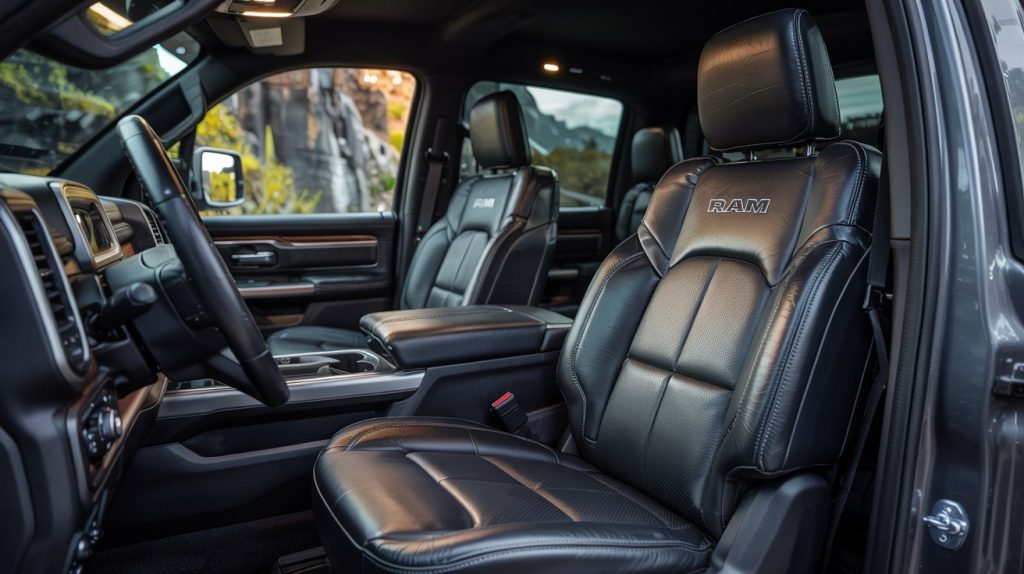Tired of your RAM 1500 having a wobbly steering wheel? Check out this step-by-step guide on straightening a bent steering wheel on your RAM 1500.
Does your RAM 1500 steering wheel slide when you are driving straight? You’re not alone. Being a fellow RAM owner, I will demonstrate how to diagnose and repair this common problem at the garage.
Let’s put your truck steering wheel back in place and get you back to that confident driving feel you love with your RAM.
Understanding Why Your RAM 1500’s Steering Wheel Is Crooked
Let’s take a look at what’s causing your steering wheel to turn in the first place. If you recently struck a pothole or slammed into a curb, that’s your fault. Such impacts will throw your alignment into disarray more quickly than you realize. Sometimes, it’s just as easy as having your tires rotated and then not properly aligned.
But what most car owners don’t realize is that it can happen with worn tie rod ends or rusted steering components too. If you’ve tinkered with your truck’s suspension, then that might also be why your steering wheel no longer lies straight. Even something as basic as uneven tire pressure can knock things off-kilter.
Related: How to Reset Computer on Dodge RAM 1500
Getting Your Tools Ready
Before we begin tearing up our sleeves, let’s make sure you are prepared. To be honest, nothing kills you more than halfway through a job to realize you’re missing a key piece of equipment.
First, you’ll need a large jack that can support your RAM weight (this should be at least 2 tons). Get your 19mm socket and ratchet extension — you’ll need these to reach into those tight spaces. It takes a high-quality adjustable wrench or tie rod adjustment tool to adjust precisely.
Make sure you have safety gear on – gloves and safety glasses are not optional. A marking pen for tracking your corrections, and a decent flashlight because, come on, you’re going to want to see the work clearly.
Safety First: Setting Up Your Workspace
I can’t emphasize this enough – safety is of the utmost importance when removing steering parts. Let me guide you through how to set it up.
So, find yourself a flat, smooth concrete workbench. Your driveway is ideal if it is flat, but don’t do that with gravel or a bump in the road – it just isn’t worth it. Be sure you have a decent amount of light and if you’re in your garage, leave that door open for ventilation.
Pull on your parking brake and tie the rear wheels. And here’s a tidbit: put chocks on the front and back wheels. It may sound like excessiveness, but there is no such thing when it comes to security.
Step-by-Step Guide: Let’s Fix That Steering Wheel
Starting With a Proper Assessment
So, before we start making any changes, let’s understand what the hell is going on. Take your RAM for a spin down a flat, straight highway. Pay attention to the angle of the steering wheel if you drive straight. Does it tip one way or the other? Consider how off-centre that wheel is sitting mentally.
Here’s a little trick I picked up over my many years of RAM ownership: use your phone to snap a quick photo of the steering wheel while you’re straight (take a passenger along with you, of course). This gives you a good starting point for later.
Getting Under Your Truck
With that out of the way, it’s time to get your RAM up in the air. Place your jack under the lifting points – if you don’t know where these are, consult your manual. It will show you exactly where to put that jack for maximum stability.
Once you have the front end jacked up, here’s my secret weapon: never do it without jack stands. Never, never ever – I mean never – rely on your jack alone. Put those stands under the frame rails and rock your truck until it’s fully stable.
Finding and Adjusting Your Tie Rods
Here’s where it gets interesting. Your tie rods are the parts that connect your steering rack to your wheels. Identify what looks like a long threaded tube with a nut on one end – that’s your adjustment sleeve.
Before turning, get out your marking pen and make a few indicating lines. Consider leaving breadcrumbs – you can always retrace your steps if something goes wrong. I also draw lines on the sleeve and the tie rod so I know exactly how many turns I’ve taken.
Making Those Critical Adjustments
Now for the bit that takes some chiding. It will take loosing those lock nuts on both tie rod adjustment sleeves. They can be a little obstinate if your truck has seen its share of snowy roads. You can also use a little penetrating fluid here.
Here’s the secret: never just set it on both sides. Think of it like tuning a guitar – you want to keep the chords consistent. When your steering wheel is leaning to the right, turn the left tie rod counter-clockwise and the right one clockwise. Start slowly – about half a turn on each side will do the trick first.
Testing Your Work
Here’s where your old photo comes in. Take your truck down and take it for another ride. Now compare the steering wheel position to your reference image. Is it better? Worse? Just right? Never worry if you fail on your first try – it may take a few tries to master.
Just keep driving at different speeds and on different roads. What looks good at the park might not look so good at the highway.
Common Mistakes (And How to Avoid Them)
Let me share some of my own experience. First, don’t rush this job. It’s all too easy to hurry things up, but putting off the project now prevents headaches down the line.
I’ve found the common mistake is that they adapt to only one side. As a hypothetical example: when you walk, you wouldn’t change the length of one leg, would you? The same principle applies here. Keep your adjustments balanced.
Troubleshooting Tips From Years of Experience
Every now and then things don’t work out as planned, and that’s fine. Try replacing worn parts if you’re turning the tie rods but the steering wheel isn’t responding properly. Get hold of each end of each tie rod and shimmy it around – if you play too much, then you have more problems to resolve.
When to Call in the Pros
I mean, I love to do my own maintenance, but you gotta learn when to let someone else do it. If your car starts clicking at turns, or your steering wheel rumbles when you accelerate, you may have more than just alignment problems. Better you get it tested than put yourself in danger.
FAQs From Fellow RAM Owners
Will this void my warranty?
If your truck is under warranty, be sure to talk to your dealer first. Some will align your steering wheel free of charge with the warranty.
How often should I check my alignment?
I suggest doing it each time you change the tires, or notice your truck is moving differently. We should never be afraid to take care of our health.
Can I drive long distances after adjusting the tie rods?
Your steering wheel might be square but I would definitely suggest getting it professionally aligned before any long drives. This keeps your tires in balance and your truck comfortable on the open road.
Keeping Your RAM Running Straight and True
Consider the alignment of your truck as the foundation of your home — you should check and repair it frequently. Check your steering system visually when you’re going under for an oil change. Take note of any strange noises and how your truck reacts.
Wrapping It Up
That’s all for now – the definitive step-by-step guide to straightening your Ram 1500’s misaligned steering wheel. Remember, this is not about style, it’s about security and driving comfort. Take your time, be patient with these tips, and don’t be afraid to get professional help if something doesn’t seem right.
Keep your tools handy, your eyes open for potential issues, and your RAM will keep running straight and true for years to come.





